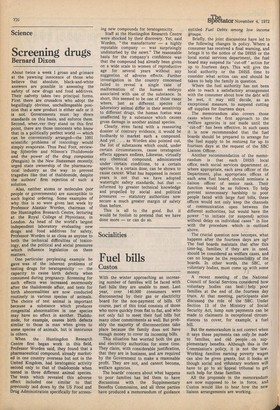Science
Screening drugs
Bernard Dixon
About twice a week I groan and grimace at the yawning innocence of those who believe that absolute, black-and-white answers are possible in assessing the safety of new drugs and food additives. Their naivety takes two principal forms. First there are crusaders who adopt the beguilingly obvious, unchallengeable position that a new product is either safe or it is not. Governments must lay down standards on this basis, and enforce them. Second, wherver they stand on this first point, there are those innocents who know that in a politically perfect world — which can be conveniently arranged—the 1001 scientific problems of toxicology would simply evaporate. Thus Paul Foot, reviewing SjOstrOm and Nilsson's Thalidomide and the power of the drug companies (Penguin) in the New Statesman recently, urged state ownership of the pharmaceutical industry as the way to prevent tragedies like that of thalidomide, despite the authors' firm rejection of such a solution.
Alas, neither atoms or molecules (nor people or governments) are susceptible to such logical ordering. Some examples of why this is so were given last week by Professor Alastair Worden, chairman of the Huntingdon Research Centre, lecturing at the Royal College of Physicians, in London. As head of the world's largest independent laboratory evaluating new drugs and food additives for safety, Professor Worden is as close as anyone to both the technical difficulties of toxicology, and the political and social pressures which influence legislation on these matters.
One particular perplexing example he gave was of the inherent problems of testing drugs for teratogenicity — the capacity to cause birth defects when consumed during pregnancy. Screening for such effects was increased enormously after the thalidomide affair, and tests for birth abnormalities are now conducted routinely in various species of animals. The choice of test animal is important because a substance which produces congenital abnormalities in one species may have no effect in another. Thalidomide, for example, causes birth defects similar to those in man when given to some species of animals, but is innocuous in others.
When the Huntingdon Research Centre first began work in this field, Professor Worden said, they found that a pharmaceutical compound, already marketed in one country overseas but not in the United Kingdom, had teratogenic activity second only to that of thalidomide when tested in three different animal species. The tests which revealed this adverse effect included one similar to that previously laid down by the US Food and Drug Administration specifically for screen ing new compounds for teratogenicity.
Staff at the Huntingdon Research Centre were shocked by their discovery. Yet, said Worden, "the manufacturer — a highly reputable company — was surprisingly undisturbed by the news." The reasonable basis for the company's confidence was that the compound had already been given on a wide scale to women of reproductive age for several years without any suggestion of adverse effects. Further investigation in the country concerned failed to reveal a single case of malformation of the human embryo associated with use of the substance. In short, this seemed to be one of those cases where, just as different species of laboratory animal differ in their sensitivity to different drugs, the human foetus was unaffected by a substance which causes gross damage in another animal species.
Clearly, even faced with a reassuring dossier of contrary evidence, it would be foolhardy to market such a compound. And yet . . . as Worden also pointed out, the list of substances which could, under certain circumstances, cause teratogenic effects appears endless, Likewise, virtually any chemical compound, administered under certain conditions, to a certain species, in a certain dose, can be shown to cause cancer. What has happened in recent years is not that we have adopted watertight safety standards, but that — informed by greater technical knowledge and propelled by social and political pressures — statutory authorities now secure a much greater margin of safety than before.
This is all to the good. But it would be foolish to pretend that we have done more — or can do so.








































 Previous page
Previous page